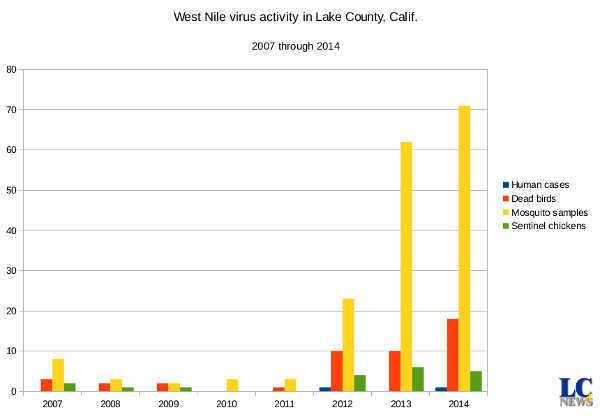LAKE COUNTY, Calif. – A new state report shows that while California has, as a whole, improved in national health goals for several conditions, Lake County continues to be ranked near the bottom for numerous health issues.
The California Department of Public Health released the County Health Status Profiles 2015 as part of National Public Health Week, which takes place April 6 through 12.
The report – which covers the years 2011 to 2013 – provides statewide and county-level data to help guide the course of health promotion and preventive services.
Lake County Public Health Officer Dr. Karen Tait said that, unfortunately, there weren't many surprises in the report, as Lake County has for some time shown poor outcomes. She added that she didn't expect to see large changes on a year-to-year basis.
CDPH's analysis of the numbers reveals that, overall, California has shown improvement in reducing infant mortality, AIDS, cancers and coronary heart disease.
California achieved goals established in the Healthy People 2020 national objectives – which serve as a guide to improve the health of people across the nation – for many of the diseases and conditions.
“The stories told by these data are quite encouraging, but we must remember that not all communities have benefited equally from these improvements,” said CDPH Director and State Health Officer Dr. Karen Smith. “Too many people in California still face chronic diseases related to factors such as poor diet, lack of physical activity and the use of tobacco.”
Statewide, AIDS incidence among Californians aged 13 and older decreased, showing an improvement of nearly 28 percent.
All cancers age-adjusted death rates – including female breast cancer, colorectal and prostate cancer – improved, with the lung cancer death-rate improving nearly 10 percent, and coronary heart disease age-adjusted death rate improved 9 percent, the report showed.
Based on the report, infant mortality during the two-year period decreased for all races. Asian/Pacific Islander improved 21 percent; black, 17 percent; white, 13 percent; and Hispanic, 7 percent. Likewise, births to teen mothers – ages 15 to 19 – showed a 28-percent decrease.
The report also showed that California met Healthy People 2020 national objectives for reductions in motor vehicle crashes, homicide, firearm-related deaths, suicide, first trimester prenatal care and breastfeeding initiation.
However, the data revealed that some chronic conditions failed to show an improvement, including age-adjusted death rates for diabetes, Alzheimer’s disease and chronic liver disease.
Lake County's specific rankings
On the county level, Lake fared poorly in the overall rankings. Compared to the 2014 report, Lake County's most recent outcomes showed a number of worsening rankings along with some notable improvements, which can be seen in the comparison chart below.
“We’ve typically ranked at the bottom or near the bottom on most measures,” said Tait. “It’s a reiteration of the same conversations we’ve had about why are we always so close to the bottom.”
Because there is always a little bit of a backlog in the data – in this case, the latest report data is for two years ago – the kinds of wellness efforts under way in the county that are generating interest and excitement “won't show up at all,” Tait said.
Lake County ranked at the bottom – No. 58 out of 58 counties – for all causes of death, drug-induced deaths and all cancers, as well as lung cancer specifically and accidents.
It received a No. 57 ranking for chronic liver disease and cirrhosis and chronic lower respiratory disease, was No. 56 for motor vehicle traffic crashes, and No. 55 for homicide and coronary heart disease.
Among Lake County's other low rankings for major health status indicators are the following: cerebrovascular disease (stroke) and suicide, No. 54; influenza/pneumonia, No. 51; and firearm-related deaths, No. 50.
The report also found that Lake County ranked No. 58 for infant mortality for Asians/Pacific Islanders, was No. 54 for adequate prenatal care and No. 50 for first trimester prenatal care.
For persons under age 18 in poverty, Lake County ranked No. 48.
Among the areas showing improvement in this most recent report were colorectal cancer, female breast cancer – which showed a significant drop from a No. 45 ranking in 2014 to No. 28 this year – as well as prostate cancer, diabetes and influenza/pneumonia.
Tait said it's important to look at the asterisks that appear next to many of the crude case and death rates in the report. She explained, “Some of our numbers are so small that the data is just not reliable,” thus the notations.
“That’s not to deny that we have issues,” she said.
Lake County's health status indicators that the report notes have small numbers and rates that “are deemed unreliable” based on fewer than 20 data elements are colorectal cancer, female breast cancer, prostate cancer, diabetes, influenza/pneumonia, motor vehicle traffic crashes, suicide, homicide, firearm-related deaths and infant mortality rates for all groups.
Regarding factors she believes that influence the county's low rankings, Tait said, “I know people don't like to talk about it, but we have a high smoking rate.”
The vast majority of the deaths from the factors where the county is ranked the lowest have ties to smoking, Tait said. “As long as our smoking rate is as high as it is, we’re going to continue to see things like that.”
Lake County's rural nature also contributes to the high rate of accidents, and the poor condition of many of the county's roads impact the high rate of collisions, she said.
“I feel optimistic that there's a lot of momentum in the community to turn these around,” Tait said, noting there's momentum in other counties, too, to make improvements.
Tait said county officials and those involved with working to improve health conditions are aware of Lake County's problems and working to address them.
“I think we may make some inroads on some of these things, it’s just going to take a really long time,” she said.
Using the data to improve outcomes
Lake County's two hospitals look at the state-compiled data in their approaches to responding to Lake County's unique health concerns.
“Sutter Lakeside Hospital uses the Lake County health data to continually assess our community’s health needs and adjust our services accordingly,” said Chief Administrative Officer Siri Nelson.
“In January, we were certified by the Joint Commission on Hospital Accreditation for our Stroke program and were awarded Primary Stroke Certification. By improving our processes we have been able to reduce our stroke patient morality, saving lives,” Nelson said.
Breast cancer is another example of how Sutter Lakeside focuses its efforts to improve lives in Lake County, Nelson said. “This year we received a $250,000 Sutter Health match grant for new 3D mammography technology that will help us detect and treat breast cancer earlier.”
Nelson said Sutter Lakeside also sees opportunities to improve diabetes and influenza outcomes and is taking action.
On April 15, Diabetes Education Day, the hospital will host an event offering free diabetes screenings, nutrition education and counseling, diabetes self-management resources, and healthy snack samples and recipes.
In October, Sutter Lakeside – in partnership with Lake County Public Health – administered more than 400 free flu vaccinations at the Heroes of Health and Safety Fair. “We hope to double that number in 2015,” Nelson said.
At St. Helena Hospital Clear Lake, the hospital recently created a new position, director of community wellness.
Shelly Mascari, formerly with the Lake County Office of Education, took the position and has been on the job since mid-March.
Mascari said one of the goals of her job is to start “moving the dials” on those poor health statistics that haunt the county. “We're hoping that it shows the public that the hospital is wanting to invest in turning this around in a significant way.”
She said the fact that she's in her new job is “a pretty big statement” from the hospital that it's time to focus the energy and resources on improving the county's health picture.
Mascari said she's now in the process of creating a strategic plan, and will use some of the content and data from the state report in building that document as well as determining what new wellness programs the hospital can create.
Working to transform a community of 60,000 is a big task, Mascari acknowledged, and in approaching it she's looking at a combination of education and outreach, new programs, the focus on individuals and inspiring them to make positive changes, and supporting programs that already are successful.
“It’s going to take all of us really working together, maybe like we've never done before,” Mascari said.
Email Elizabeth Larson at This email address is being protected from spambots. You need JavaScript enabled to view it. . Follow her on Twitter, @ERLarson, or Lake County News, @LakeCoNews.
2015 Lake County Health Status Profile Summary
2015 County Health Status Profiles Comparison by LakeCoNews













